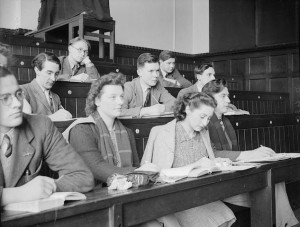
Students in classroom lecture, King’s College London.
License: http://www.iwm.org.uk/corporate/privacy-copyright/licence
The lecture has been a dominant mode of instruction for centuries. It generally entails the professor delivering information on a particular subject matter, using a well crafted set of notes, incorporating visuals and anecdotes, the delivery of which has often been refined over several years. The lecture is construed as a one-to-many form of delivery and has served well for a long time.
The lecture method has its detractors who frown upon its tendency to privilege a “sage-on-the-stage” environment. While our sages have spent an enormous amount of time becoming experts in their respective fields- and as such, I think are well suited to inhabiting the “stage”- there are reasonable calls for diversifying classroom delivery and engagement strategies. Some see this as a shift to professors incorporating a “guide-on-the-side” method that adopts “active learning” strategies, and emphasizes lectures less. Students may not readily accept “active” learning practices at first, reminding us that there are challenges to any strategy.
The lecture mode isn’t dead, nor should it be cast aside to the dustbin of pedagogy. It has been- and can remain- a relevant and effective classroom practice. But it is no longer the only “game” in town and need not provide the backbone of student experience.
There are certainly ways to improve the lecture experience. Allowing for questions is an obvious means of keeping students engaged. Lecturing for short bursts of 15 to 20 minutes, interspersed with other engagement practices is a good technique as well.
The bottom line is, while the lecture method can be ineffective if done incorrectly, there are benefits to extending and adapting it into a larger set of classroom instruction strategies.

Recent Comments